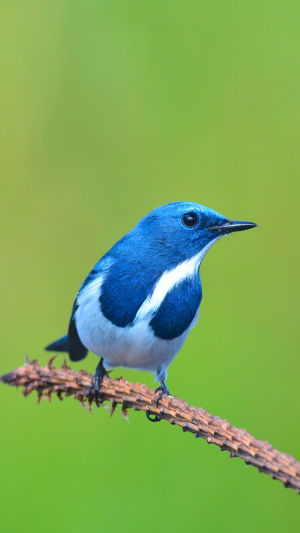The white-browed blue-eyed flycatcher (Eumyias thalassinus) is a species of bird in the Muscicapidae family, known for its striking appearance and widespread presence in Asia.
With a body length of approximately 13 cm, the white-browed blue flycatcher is relatively small.
Its plumage is a captivating blend of blue and gray, complemented by a white breast, belly, and a distinct eyebrow-like stripe on its forehead, from which it derives its name.
While males may display more vibrant colors, both males and females share a similar appearance.
This bird primarily inhabits mountains and forests across Asia, including countries such as India, Nepal, Myanmar, Thailand, and China.
It prefers to dwell in the upper reaches of trees, skillfully hopping on branches while foraging for insects, spiders, and small invertebrates.
Its melodic chirps resonate through the air, occasionally mimicking the calls of other avian species.
During the winter season, the white-browed blue flycatcher embarks on a migratory journey from high-altitude regions to lower altitudes.
Often found in pairs or small groups, these birds exhibit territorial and aggressive behavior, vehemently warding off intruders with their threatening calls.
Renowned among bird watchers and nature enthusiasts, the white-browed blue flycatcher is celebrated for its vivacious nature and captivating presence.
It stands as one of the most common birds in Asia, a testament to its popularity and abundance in the region.
The breeding season for the white-browed blue flycatcher typically occurs in spring and summer.
During this time, they carefully select concealed locations such as tree hollows or cracks in tree trunks to construct their nests.
Females are responsible for building the nests, which are crafted using dry grass, moss, and leaves.
Each clutch typically consists of 3 to 5 eggs.
While the female diligently incubates the eggs and tends to the chicks, the male takes charge of foraging and providing sustenance for the growing brood.
It takes approximately 12 to 14 days for the fledglings to leave the nest, although they still rely on their parents for nourishment until they can fend for themselves.
White-browed flycatchers exhibit an omnivorous diet, supplementing their insect and invertebrate intake with fruits and nectar.
Their agile flying skills are showcased as they energetically leap into the air, swiftly capturing insects mid-flight.
Although the white-browed blue flycatcher faces threats such as habitat destruction and illegal capture in certain regions, its wide distribution, and relatively stable population have led to its classification as a "Least Concern" species by the International Union for Conservation of Nature (IUCN).
Enthusiasts of avian observation and nature admirers find joy in observing and documenting the behaviors and distinct calls of the blue-browed flycatcher.
Their exquisite appearance and lively demeanor mark them as captivating members of the natural world.
Despite their current "least threatened" status, conservation efforts remain vital to ensure the flourishing population and sustainable habitat of the white-browed blue flycatcher.
Key protective measures include:
1. Habitat Conservation: Safeguarding the habitats of these flycatchers, encompassing forests, mountains, and other critical areas, is imperative. Protection can be achieved through the establishment of nature reserves, responsible forestry management practices, and the promotion of sustainable development principles.
2. Control of Illegal Harvesting and Trade: Effectively monitoring and enforcing regulations against illegal capture and trade is necessary to combat these threats.
Strengthening both national and international laws, raising awareness about the consequences of illegal activities, and fostering cross-border cooperation are vital steps.
3. Education and Awareness Initiatives: Increasing public awareness about the white-browed blue flycatcher and its conservation is essential. Educational campaigns, exhibitions, and social media platforms serve as effective channels to disseminate information regarding the species, conservation requirements, and actionable steps for protection.
To ensure the long-term survival and sustainable development of the white-browed blue flycatcher, comprehensive conservation measures encompassing habitat preservation, regulation of illegal activities, education, scientific research, monitoring, and international collaboration are of paramount importance.
Through the implementation of these measures, we can safeguard this remarkable bird and its habitat for generations to come.





